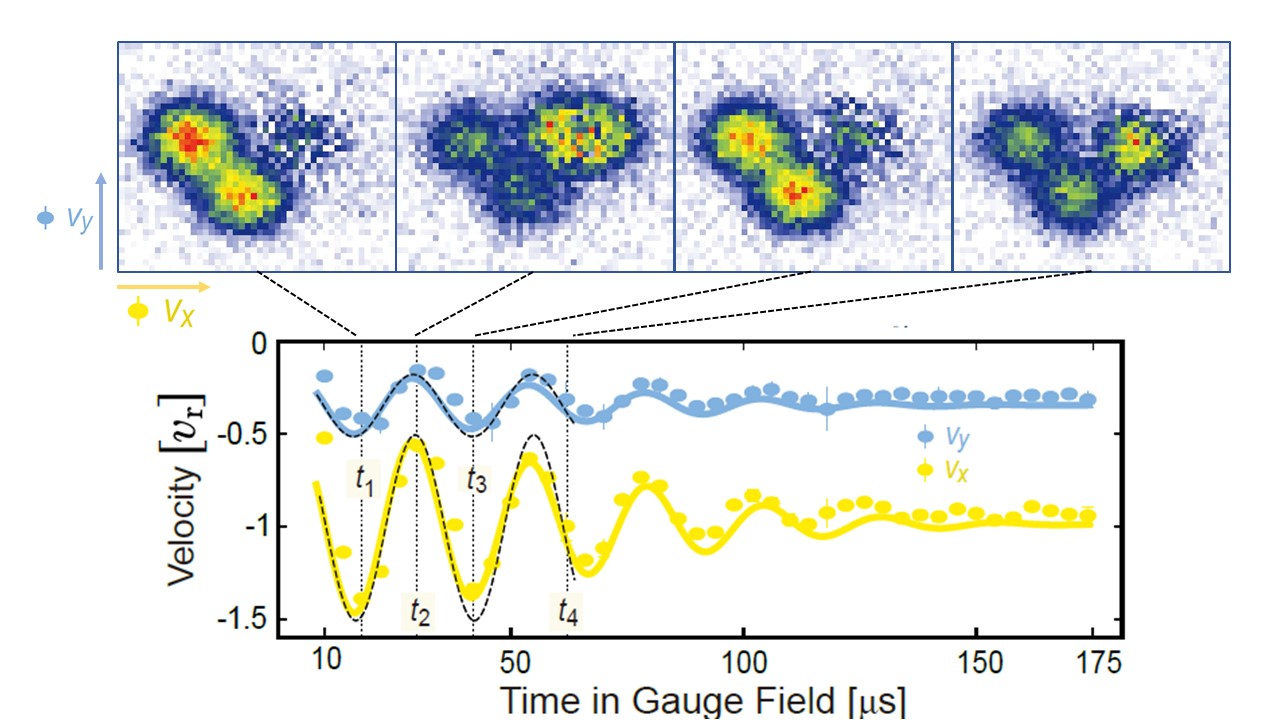Highlights
Trembling signals how cold atoms could simulate high-energy physics
 CQT Principal Investigator David Wilkowski with his group’s strontium setup. In the group’s new experiment, they observed how the strontium atoms moved in a constant gauge field. This builds upon their work done in 2018 with stationary strontium atoms.
CQT Principal Investigator David Wilkowski with his group’s strontium setup. In the group’s new experiment, they observed how the strontium atoms moved in a constant gauge field. This builds upon their work done in 2018 with stationary strontium atoms.
CQT researchers have advanced a technique that scientists could use to simulate high-energy physics, traditionally probed in the extreme conditions of a particle collider, on a tabletop.
In Physical Review Letters on 19 September, the group of CQT Principal Investigator David Wilkowski reports having measured an oscillation of ultracold atoms that falls into the category of a ‘Zitterbewegung’ effect, or relativistic trembling motion.
The Zitterbewegung effect is predicted by the relativistic Dirac equation, which describes the behaviour of certain particles including electrons. It has never been observed so far in a real particle, but experiments have sought to simulate it with non-Abelian gauge fields.
Gauge fields underly modern quantum field theories. They are models that provide a mechanism for particle interactions. David’s group studies the behaviour of ultracold strontium atoms immersed in an artificial gauge field, specifically an SU(2) non-Abelian gauge field.
“Non-Abelian gauge fields are interesting because they are fundamental in nature, and lead to different dynamical behaviour than their Abelian counterparts,” says David. As well as being connected to high energy physics, they are also used in condensed matter physics.
SU(2) refers to a symmetry relating to the quantum spin of the particles. The non-Abelian gauge field couples the spin to the dynamics of the atoms and causes a Zitterbewegung effect that has properties equivalent to the spin Hall effect, where different spin components separate in opposite directions perpendicular to the movement of the atom.
Physical Review Letters highlights the paper as an Editor’s Suggestion and featured the paper in Physics, an online magazine from the American Physical Society.
David’s co-authors on the paper are current and former group members Mehedi Hasan, Chetan Sriram Madasu, Ketan Rathod and Kwong Chang Chi, CQT Visiting Research Professor Christian Miniatura, and collaborator Frédéric Chevy who is based in France. Many of the authors are also researchers of MajuLab, the joint research unit which supports collaboration between Singaporean and French research institutions.
Novelty from continuity
“This really has been a continuation of our work from 2018,” says David. That’s when the group first reported results from studying strontium atoms in an SU(2) non-Abelian gauge field. Then, the researchers observed how stationary atoms behaved in a gauge field that was changing in time. In the new experiment, the researchers let the atoms move in the gauge field while keeping the gauge field constant.
 In the top panels, the fluorescence images of the strontium atoms’ velocity distributions at various times in the gauge field. Here vr = 6.5 m/s is the recoil velocity. In the bottom panel, the averaged velocity measurements of the atoms along the x- and y-axis. Credit: Physical Review Letters 129 130402, (2022).
In the top panels, the fluorescence images of the strontium atoms’ velocity distributions at various times in the gauge field. Here vr = 6.5 m/s is the recoil velocity. In the bottom panel, the averaged velocity measurements of the atoms along the x- and y-axis. Credit: Physical Review Letters 129 130402, (2022).
The experiments’ schemes are the same. With three red lasers set up in a tripod arrangement on a horizontal plane, the researchers create the non-Abelian gauge field by getting the lasers to interact with the internal energy states of the atom.
What the team had to do differently for this more recent experiment is cool their strontium atoms to even lower temperatures than before. They learned to use a method known as evaporative cooling. As you would blow on a hot cup of coffee to cool it down by removing steam from the surface, evaporative cooling removes the hot atoms from the trap and so lowers the temperature of the remaining atoms. The team’s measurements were performed on clouds of some 50,000 atoms cooled to around 30 billionths of a degree above absolute zero.
When the atoms were given a nudge, instead of moving along a straight line, the atoms oscillated because of the way the non-Abelian gauge field acts on the spin of the atoms. The team further observed that the oscillation always occurs perpendicularly to the momentum of the atom. These are the Zitterbewegung and spin Hall effects.
The team plans to take further steps towards simulating more complicated systems. In terms of gauge fields, the team wants to go from a symmetry of SU(2) to SU(3). “SU(3) is the symmetry that you find in quantum chromodynamics in high energy physics. It would be a new step towards simulating high energy physics problems with ultracold gases,” David says.
Learn more
Related Stories
 | Meet David Wilkowski, putting a new spin on cold strontium atoms May 06 2020 |
Experiments reveal new potential for cold atoms in quantum simulation September 06 2018 |






